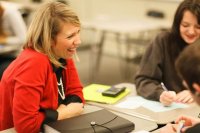Academic Discourse and PBL
Sammamish High School has defined seven key elements of problem-based learning used in our classrooms. This week we will explore the key element of academic discourse. How students communicate their discoveries and connect them to the overall learning is an essential part of what we do. Without proper communication, progress cannot be made on many projects.
What is Academic Discourse?
Academic discourse encompasses the idea of dialogue, the language used, and a format that facilitates a high level of communication in the classroom. The discourse can range from peer-to-peer discussion to whole-class discussion and can take on many forms: metacognition, presentations, debate, listening, writing, and critiquing others' work. What is important is that students are able to process and interact using academic vocabulary.
Academic discourse is not something that comes easily to most students; rather, it is something that needs to be taught, modeled and recognized by both teachers and students. With strategic instruction around what academic discourse sounds, looks and feels like, it can be a useful tool that enriches all classroom interactions and facilitates deeper learning and retention. As we developed the key elements of our program, the math department reflected on how academic discourse could become stronger in our classrooms.
We defined the most important components of academic discourse within a math classroom and developed an approach to implementing these components.
- We set the expectation that students will present problems and explain how they reached their answer.
- We emphasized the importance of using correct vocabulary. For example, math students often confuse an expression and an equation. Making that distinction is important for students. To retain the difference between the two words, they must practice using those words.
- We made writing in math a norm. Students will be expected to write about the process of how they reached an answer. This serves as another way of seeing how students are processing the material and how they are applying vocabulary words.
Processing the Problem
Through our problem-based learning curriculum, the complexity of problems forces students to communicate with each other more than if they were just working on individual homework. In our unit called "How can the student store maximize their profit?", students work in groups to study a product and how sales would change based on a price increase or decrease. They look at the cost of that product and, based on the data, create a quadratic equation to determine profit. This quadratic tells them at what price change the student store can maximize its profit for that specific product. Students are completing this project while learning about quadratics, so it presents many difficulties. For example, students need to process what each axis represents, and how income, profit and cost are related in this context, identifying break-even points and the vertex.
When presented with a PBL task that is especially difficult, students need one another to process their thinking, providing a natural way for them to become more comfortable with academic discourse. At the end of this unit, students were asked to individually write a letter to the student store recommending a price change. This was a way to assess their use of vocabulary and how their interactions contributed to their understanding of the material. It is also important for students to self-assess their understanding of the material. Processing techniques might include starting the period with vocabulary games, or having students reread their writing and underline the vocabulary words they used.
After completing a unit where students are dependent on communicating with group members, academic discourse is elevated in the classroom. Students cross the threshold of being nervous as they begin talking to their peers about their learning. Prior to implementing our problem-based learning curriculum, most student discourse consisted of students comparing answers. With practice, students find that discourse helps deepen their processing and validates their contributions to the group. As a teacher, modeling academic discourse is essential, but acknowledging students for their academic discourse is what makes it stick in the classroom.
Over the past year, we have established that increasing academic discourse also increases classroom engagement. When students are more likely to interact with their peers and take part in discussions, the long-term benefits of their understanding of the material are apparent in other math courses.
Editor's Note: Visit "Case Study: Reinventing a Public High School with Problem-Based Learning" to stay updated on Edutopia's coverage of Sammamish High School.
